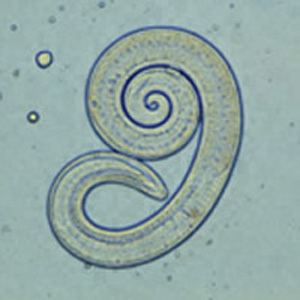Scientific name Trichinella | Family Trichinellidae Class Adenophorea Phylum Nematoda Rank Genus | |
 | ||
Similar Trichinella spiralis, Roundworms, Trichinella nativa, Trichuris, Threadworm | ||
Safer reliable method for trichinella meat inspections
Trichinella is the genus of parasitic roundworms of the phylum Nematoda that cause trichinosis (also known as trichinellosis). Members of this genus are often called trichinella or trichina worms. A characteristic of Nematoda is the one-way digestive tract, with a pseudocoelom (body cavity made up of only an ectoderm and endoderm).
Contents
- Safer reliable method for trichinella meat inspections
- Trichinella spiralis observada en triquinoscopio
- Phylogenetics
- Prevalence in animals and humans
- Treatment
- Prevention
- References
The genus was first recognised in a larval form in 1835. The L1 larvae live in a modified skeletal muscle cell. The adult worms occupy a membrane-bound portion of columnar epithelium, living as intramulticellular parasites. Infections with this genus have been reported from more than 150 different naturally or experimentally infected hosts. It has been shown to have a worldwide distribution in domestic and/or sylvatic animals.
Trichinella is known as the smallest human nematode parasite, yet it is also the largest of all intracellular parasites.
Oral ingestion of larvae-contaminated tissue is the usual route of infection, but congenital and mammary transmission can occur in rats.
Trichinella spiralis observada en triquinoscopio
Phylogenetics
Eight species are currently recognized. Four additional genotypes require adequate description before they can be recognized as valid species.
Two main clades are recognized in the genus: one group (T. britovi, T. murrelli, T. nativa, T. nelsoni, T. spiralis) that encapsulates in host muscle tissue and a second (T. papuae, T. pseudospiralis, T. zimbabwensis) that does not.
The nonencapsulated group infects saurians, crocodilians, and other nonavian archosaurs (T. papuae, T. zimbabwensis) and birds (T. pseudospiralis). The encapsulated group infects synapsid and mammalian hosts. T. spiralis and T. nelsoni appear to be basal in the encapsulated group and T. murrelli and T. nativa the most recently evolved.
Prevalence in animals and humans
Trichinella species can infect swine, horses, wild animals (foxes, wolves, bears, skunk, raccoons, rats, and other small mammals), and humans.
In swine, the prevalence varies from country to country, and regionally. Long-standing meat inspection programs in some European countries have drastically lowered prevalence rates among domestic swine. Domestic swine can be exposed to the parasite by:
In wild animals, Trichinella infection rates vary from region to region and seem to increase in colder climates. Foxes, wolves, and bears have the highest infection rates, but small mammals, such as skunks, raccoons, and rats, provide the highest risk to infecting the domestic pig. In horses, natural infections are rare; however, infected horses from Mexico and Romania have been identified.
Human infection caused by the domestic pig varies from country to country. While some countries do not report any human infection, other countries in Eastern Europe and Asia report hundreds or thousands of cases annually.
The United States reported 25 cases per year from 1991–1996, with few implicating raw or undercooked pork. Documented sources of human infection have also included game meats, such as wild boar, bear, walrus, fox, and cougar. During 1997–2001, meats other than pork were the most common source of infection, with more cases associated with home-raised pork than commercial. The decreased incidence of trichinellosis in the United States has resulted from changes in pork industry management standards and government regulations.
In Finland, meat inspection revealed a small but worrisome number of swine infections in the early 1980s, peaking in 1996. However, due to the swine industry's modernization process, the number of cases decreased, with the last infected swine diagnosed in 2004. As of 2005, only eight known human infections were reported in Finland since the 1800s, with the last one more than three decades ago.
A study of the sera from 197 wild boars from 25 farms slaughtered in Finland between 2007 and 2008 found four (2.0%) of the sera, originating from three (12.0%) farms, to be Trichinella-seropositive.
Trichinosis is often diagnosed in humans once the larvae invade the muscle tissue. Some symptoms include fever, myalgia, malaise, and edema. Trichinosis treatment focuses on reducing inflammation, and corticosteroids are usually administered. This treatment often leads to complete recovery, but muscle pain and weakness may persist.
Treatment
Treatment is by either thiabendazole or mebendazole.
Prevention
Cooking pork meat properly or by freezing pork, Trichinella infection can be prevented. However, freezing pork is not an effective method for killing larvae.
One way to prevent trichinellosis is to cook meat to safe temperatures (145 °F (63 °C) and a three-minute rest for fresh pork). A food thermometer should be used to measure the internal temperature of cooked meat. The meat is not safe until cooking is completed. To help prevent Trichinella infection in animal populations, pigs or wild animals should be prevented from eating uncooked meat, scraps, or carcasses of any animals, including rats, which may be infected with Trichinella, in order to break the oral ingestion cycle of infection.
